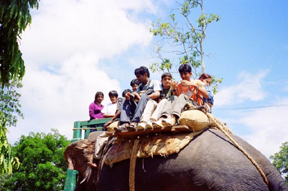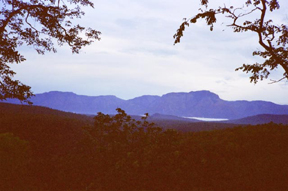Inside the woodlands of Wodeyars
Part III
-Saraswati Kavula
Bandipur is still a free zone for animals. “The deer are eating up all my plants,” complained Gangaswamy at breakfast time after we returned from our trek. He did look absolutely displeased
about this fact. But isn’t this animal territory, which we are encroaching upon, making buildings and plying vehicles? Speaking of excluding others, there is this small hamlet a few hundred metres away from the lodge, I was sure it belonged to the local adivasi
people, who must have been living there for a long time. Or may be they were removed from the core area of the forest in order to “protect” the animals. When I went past that village on a walk the previous day, I could sense a feeling of hostility and of being
watched like an alien by them. I am sure; they feel left out of all
this eco-tourism’s Grand Plans. And the area in which they lived in harmony earlier, must seem like a hostile place. While there is firewood available for the campfire at the lodge,
the local people do not have access to firewood in the nearby shrub forest. “We get the firewood from the yard”, Nataraj told me on enquiry. The locals may not have the means to purchase wood from the logging yard, for their needs. On
day three, while we were returning from the Gopalswami betta, we saw some men trying to cut some shrub trees, Pradeep our driver, who earlier worked in the forest department, shooed them away. I suppose it was his basic instinct.

What surrounds the Bandipur periphery area is just shrub and denuded hills, though the cover increases in the interiors of the Sanctuary, it still doesn’t meet up the description of
a rain forest. I expected to see thick rain forest there, and on enquiry I was told, “This is semi-deciduous forest, so most of it is just shrub jungle”. I did see really huge trees and a thicker jungle a few kilometers away when we went for the Safari. So,
it could not be that much different here. Most of the trees inside the Safari area were not very old, may be a couple of decades - not more than that, and obviously plantations, as one could make out from the unnatural bamboo plantations in that region.
But still the animals were there and that is the thing to be happy about. On the second day afternoon, since the rain had cleared, there were quiet a lot of animals to be seen in the
safari, chitals, sambar, langoors, peacocks. The surprise was the sight of a huge herd of Bisons which we chanced upon as we went past in the safari area. The animals were a treat to watch, but everyone was dead silent, since the bison was also a ferocious
animal, with 500 kilos of sheer power. “Don’t you use the flash, the Bison doesn’t have good eyesight, but if it senses our presence, we are done for”, Purshottam remarked. After a few quick snaps of the herd, we rushed out of the place soon enough, before
the big animals could sense what was wrong. Just then Gangaswamy came up and told us about a herd of elephants that they have seen at close quarters. “I have been trying to tell you over the walkie-talkie about this,” he fumed at Pradeep. Pradeep took the
directions and as we tried to skirt the area, we met with two more herds of Bisons and some real big sized Sambars as well.

Purshottam told Pradeep to take us to Veerappan’s valley. “Last time we went walking down that valley. We may not be able to do that this time, since
it has rained and would be slippery”. As we went deeper into the forest towards the valley that rests between the Karnataka and Tamil Nadu borders, we suddenly came upon a Sloth Bear waiting on the dirt road. “It is really a rare sight to see the sloth bear”
Pradeep remarked. Every one got excited and before the flashbulbs of cameras could work, the animal scooted. The view of the valley from the gorge was a fabulous sight. “That other side of the valley is TamilNadu and this side is Karnataka. Veerappan used
to habit the valley. So when any
police had to nab him, they had to come down the the gorge, which was quite steep, but also seen from the valley below. The moment he saw anyone coming down the valley, he would shoot
them down.” Purshottam recounted us the times of Veerappan, the famed Sandalwood smuggler, who now rests
in peace.
On our return we saw a very poignant film by Shekar Dattari on the loss of the habitat inside the Madumalai Biosphere, which disrupted the movement of the elephants through the Elephant
corridor spanning the three states – Karnataka, Tamil Nadu and Kerala; due to the massive growth of coffee plantations in the area. The area has become a famed tourist destination, “Coorg” which is flocked by people (like me) wishing to escape the summer heat.
The elephants now have to cross the plantations in order to reach the watering holes of Kabini River on the other side of the biosphere and in the process are either scared with the use of firecrackers or worse, shot at by the plantation owners.
What a thing to do, watching such a film, inside a “touristy” wild life resort, educating ourselves about the problems of the Grand animal, due to coffee plantations, while sipping
coffee! During our post film discussion, one of the lodgers mentioned of this place inside another National Park (can’t recollect the name now) where one can stay
inside tree houses and get to watch the animals uninterrupted. The icing on the cake was his remark, “It is owned by the nephew of the Nawab of Pataudi, in case you know him personally,
do go there. Though it is meant for hiring out, most of the time, his friends keep taking up the accommodation. I heard it is a fabulous place. Absolute five star facilities inside those tree top houses!” Wow!
What is it that makes us want to take our comforts with us while we want to watch nature and our fellow species, without disturbing them? Or is it that, like everything else, wildlife
tourism is meant for a kick of doing something different, a game, a sort of an entertainment? Looking around me, I felt that must be the case. Seeing wild animals is also something to tick each other off with, “Oh we saw the tiger so close by!” (By God, what
an adventurer I have been, while you are such a sissy, partying and going to the beach!)
More than that, how come, the nawab’s nephew gets to set up a resort bang
in the middle of a wild life park, while Bandipur Safari Lodge owned by the Karnataka forest department is set outside the sanctuary area; more so, while most tribals are thrown out of their ancestral homes inside the forest, in order to “Protect the Wildlife
from human activity?”

( Photographs in order from top: Elephant ride in Bandipur, Veerappan’s Valley, Coffee plantations in Coorg)